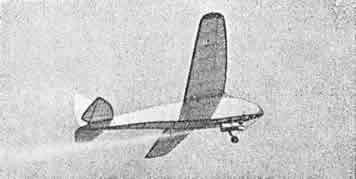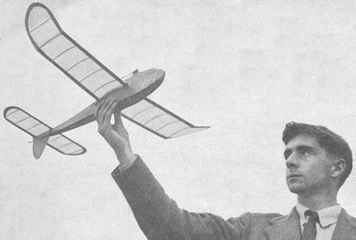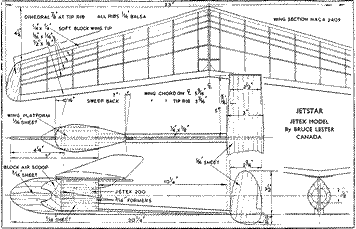|
Zephyr
by H.E. Hervey (1948)

Click image to view or download enlarged dimensioned plan
and building and flying hints

- Aeromodeller,
June 1948 (p.355)
|
 |
Zephyr is famous as one of the first two published plans
for the new Jetex motors, announced in the same issue as that in which this plan appeared.
H.E. Hervey was specially commissioned by Aeromodeller to design a free-flight duration
model which would demonstrate the effectiveness of the new motors for powering this type of
model.
There is no motor size specified on the plan, "but", says Bill Henderson, who contributed our
copy, "34½ inch span is Jetex 200 size, by my standards."
|

|
|
Firecrest
by Dick Twomey (1949)

Click image to view or download enlarged dimensioned plan
and building and flying hints from Dick Twomey

- Model Aviation (UK),
Feb. 1950 (p. 20)
|
 |
Firecrest has a unique claim to fame in that it was the winner
of the inaugural ICI Jetex contest in 1949.
A key ingredient in its success was the carefully thought-out placement of the motor:
"Firecrest is one of the few Jetex-powered models which has not followed
conventional lines – that is, the high wing, pod-and-boom type with the
underslung jet unit mounted in the rear of the pod. With the jet unit mounted just above the wings the line of thrust
coincides, or very nearly so, with the centre of resistance so that optimum trim
can be obtained both under power and on the glide. This then enables a very
efficient rigging to be adopted, where the centre of gravity is moved well aft
so that the tailplane is carrying part of the total load."
|
|

|
|
Jetstar
by Bruce Lester (1949)

Click image to view or download enlarged dimensioned plan

- from the Aeromodeller Annual,
1949 (p.60)
|
 |
The Canadian designer of Jetstar, Bruce Lester notes:
"Avoid thick airfoils if you want to get high performance and still design models
of a good relative size. In all 'Jet' planes using the 'reaction' principle for
proplusion, the 'drag' factor is one of the greatest performance killers even
full-scale designers have to contend with."
|
Following his own advice, Bruce used a NACA 2409 airfoil for the Jetstar.
|

|
|
Twizzler
by Dick Twomey (1951)

Click image to view or download enlarged dimensioned plan
and building and flying hints from Dick Twomey

- Aeromodeller (UK),
Oct. 1951 (p. 593)
|
 |
Twizzler was a development of Dick's contest-winning
Firecrest. Modifications were aimed at reducing drag
in order to increase climb rate:
- a slimmer fuselage
- less fin area
- faster wing section
- lighter overall weight.
Other changes were an enlarged tailplane with dihedral tips and an off-set
Jetex unit.
The success of these modifications was borne out by Twizzler's win
in the R.A.F. Championships of 1950 – and, ten years later, by
Dave Hegarty's Twizzler's winning the Jetex division of the
Australian Nationals in 1960 (see
photo).
|

|
|
Sipa 200
by E. Chelle (1953)

Click image to view or download
large dimensioned plan
- Le Modèle Réduit
d'Avion, Oct. 1953 (cover)
|
 |
Sipa 200, a 1/10 scale model of the French jet trainer, is a token of the keen interest
in Jetex that prevailed in France.
The premier French magazine for scale aircraft modellers Le Modèle Réduit d'Avion
published this design for Jetex 200 (alternatively Jetmaster) with augmenter tube bell mouth.
M. Chelle saw the advantage of using the Jetex 200 as "being able to choose between
loading one or two pellets,
which doubles the length of the powered phase while maintaining the same thrust".
|

|
|
Stiletto
by Dick Twomey (1954)

Click image to view or download enlarged dimensioned plan
and building and flying hints from Dick Twomey

- Model Aircraft,
May. 1954 (p. 184)
|
 |
Model Aircraft called Stiletto "a contest model for the Jetex 200 by one
of the experts".
This Dick Twomey design was a further development of his contest-winning
Firecrest. Lighter construction, reduced wing area,
and a smaller fuselage cross-section were all targetted at producing a steep, fast climb.
The result was a fourth placing for Stiletto in the 1953 I.C.I. Challenge Trophy Contest, in the face of
adverse flying conditions and stiff competition.
|
|